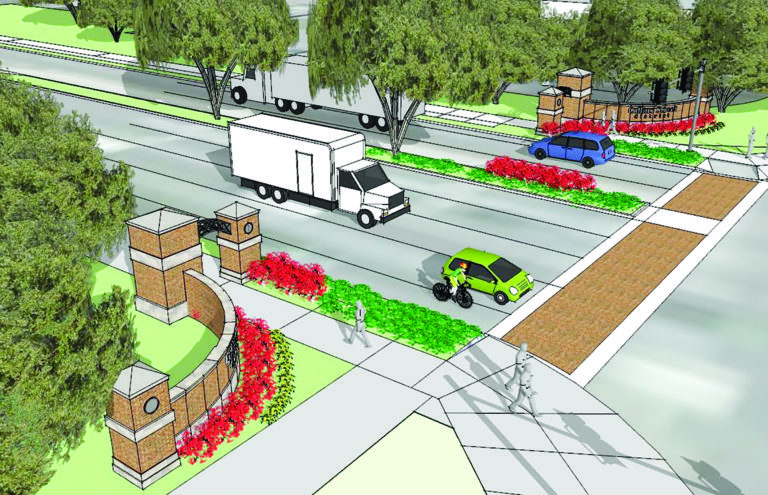
Plant City’s first Complete Street phase is funded and design work is nearing completion.
Collins Street is about to get a trendy makeover.
Plans to turn Collins Street and a portion of James L. Redman Parkway into a shared-use roadway, or Complete Street, have moved from concept to creation as the first portion of the two-mile project is fully funded and undergoing its final design.
Like many roads constructed since the post-World War II rise of interstate systems and increased automobile usage, Collins Street is heavily catered to automobile traffic. However, recent trends in urban planning have put a focus on creating roads with equal accessibility to all, whether they be drivers, cyclists, pedestrians or straphangers.
“We’ve quite often designed our streets and roads to be auto-dominate,” Wiatt Bowers, senior transportation and land use planner with Atkins, said. “Complete Street doesn’t favor one (mode of transportation) over the other.”
The Complete Street concept was born in the early ‘70s, but it wasn’t until the mid-aughts and the 2005 creation of the National Complete Street Coalition that advocacy for shared-use roadways began to enter a major spotlight.
The plan to “complete” Collins Street, one of Plant City’s main arterial roadways, has been in the conceptual stages since the city asked the Hillsborough County Metropolitan Planning Organization (MPO) to create a study of the street in 2013. That study and the conceptual designs for Collins Street were completed in October of 2013. The plan calls for a major overhaul of Collins and Redman from the intersection of Alexander Street and Redman Parkway, two miles north to Collins and Reynolds Street. When completed, it will be Plant City’s first Complete Street.
The first section to be complete will be a stretch of Collins from Laura Street around Alsobrook street in the midtown district. According to City Engineer Mike Schenk, the project has moved from the concept phase to being designed, with a proposal expected to reach the city commission in the next 30-to-60 days.
The project’s first phase is being funded with $700,000 the Florida Department of Transportation paid to Plant City as part of the deal to swap control of Alexander Street (from city to state) and Collins (from state to city) and $750,000 secured from the Florida Legislature for the project.
While the $1.45 million revamp only represents about 25% of the total project length, it’s expected to be the most labor-intensive portion of the project. Schenk said the city plans to move power lines underground, freeing up space for wider walkways, bike lanes and on-street parking. The street will also undergo a “road diet,” Bowers said, reducing the number of vehicle travel lanes in the area.



In addition to enhancing the roads to accommodate all modes of travel, the design of the Complete Street brings a thematic identity to the road using specific materials and signage, gateways to mark transitions into different parts of the city and streetscaping, including the addition of medians and landscaping to separate sections of the road.
Plant City’s railroad history was taken into account in the aesthetics for the project, incorporating lots of brick and steel to keep with design elements already established in midtown’s Village Green Park.
“It will be an attractive street that really compliments what’s been going on in the area,” Schenk said.
The design also incorporates elements of the long-term plans to enhance Plant City’s pedestrian and bicycle facilities. It even got a nod for safety from the MPO’s Vision Zero project manager, Gena Torres. Vision Zero is an international effort to reduce road fatalities to zero. Hillsborough County is consistently ranked among the worst in the country for road safety. Plans like the Collins Street project, Torres said, can help change that.
“That one in particular is a great example of a strategy that will get us towards zero fatalities on our road ways,” Torres said. “It’s a great example of the type of project that can help reduce those types of fatalities and injuries.”
With the final plans nearing completion and funding secure, Schenk said construction should begin by early to mid-2018 and take nine to 12 months to complete. Other sections of Collins will continue to be updated as funding is secured. Getting that first portion of the project started within five years of concept designs, however, is remarkable, Bowers said.
“I’ve worked on projects with a 20 to 30-year shelf life that have had no implementation,” he said. “A substantial portion, a strong part, could be implemented by 2018. That’s impressive.”
